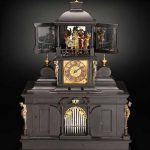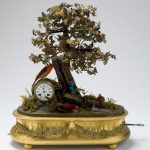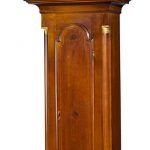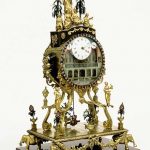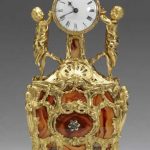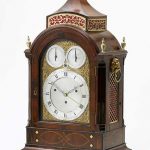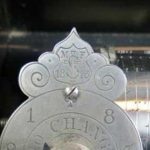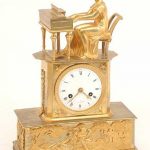Musical Clocks. A musical clock is a clock that marks the hours of the day with a musical tune played from a spiked cylinder either on bells, organ pipes, bellows, and for quartz clocks, using an electronic sound module.
One of the earliest known domestic musical clocks was constructed by Nicholas Vallin in 1598, and it currently resides in the British Museum in London. Reference: Wikipedia
Musical Clock with Musical Clock and Organ,ca. 1625 Veit Langenbucher German
Inside the ebony case of this musical clock is an extremely rare and important instrument consisting of a sixteen-note pipe organ and a sixteen-string spinet that may be played independently of the organ. Made by the renowned team of Samuel Bidermann and his son (also Samuel)–the father’s L-shaped pinning style appears in this work–and Viet Langenbucher, the extraordinary piece includes, in addition to the organ and spinet, a clock and five carved and colorfully clad commedia dell’arte figures that perform a circling dance in the clock’s tower when the instruments sound to mark the hours.
The complex clock is perhaps the most musically elaborate automatic instrument to survive from the early seventeenth century. Its three airs, probably by composer Hans Leo Hassler (baptized 1564-1612), the elder Bidermann’s teacher and once keeper of the knowledge of pinning barrels in Augsburg, are stored on the original pinned cylinder. Most cylinders and their tunes were replaced by subsequent generations, but this one was spared to provide us with an extremely rare musical document that allows us to hear the airs as they were played in the seventeenth century.
Reference: The Metropolitan Museum of Art
French musical automaton fitted with clock, 1870-1900 Made c 1890 This automaton features six colourful animated birds, a waterfall, a tree surrounded by rocks and plants, a pond with three miniature waterbirds, and a clock. The mechanism, including bellows and a flute to reproduce bird calls, is hidden in the base and activated by a key. While the names of its makers are unknown, it was probably crafted in Paris in the late 1800s, with clock by Japy Frères (Japy Brothers) and automaton by the Bontems family. Blaise Bontems (1814-1881) was renowned for making automata with realistic songs, including those of the nightingale, canary, finch and blackbird.
This automaton incorporates a clock, making it useful as well as decorative and entertaining. It would have taken days to make, with each silk leaf and flower, and each real feather, carefully attached by hand. The bird in the centre whistles, two birds peck, two fly from branch to branch, and one flutters its wings, all activated by gears, levers, springs and cams and controlled by a pinned cylinder like those in music boxes. The leather bellows blow air through the tiny flute, and cams vary the length of the flute’s air column to produce different notes and thus simulate the song of a particular bird species.
Reference: Museum of Applied Art and Sciences
Exceptional Federal Cherrywood Tall Case Seven-Tune Musical Clock, Martin Cheney, Windsor, Vermont, Circa 1809 dial inscribed M. Cheney / WINDSOR and the tunes: St Mary. = Marquis of Granby. = Duke of Argyle = Mrs Casey = New Jersey = Scotch Luck = Pleasures of Solitude. Height 105 in. by Width 26 in. by Depth 14 in.
Sold for 87,500 USD at Sotheby’s in 2018
This musical clock by William Carpenter is typical of the kind of elaborate exotic time-piece made in London for export to the East in the late 18th century. Turkey, China and India were the principal destinations for these clocks.
The measurement of time was only one small feature of these clocks. This clock offered a choice of six tunes – two dances, two jigs, a song and a march. The figures dressed in 18th-century costume mounted on the clock, hold bells. The standing figures chime the quarters and strike the hours; the seated figures play the tunes on bells below their feet. These clocks were eagerly bought by Eastern rulers and merchants and were thought of as interesting toys. Examples can still be found in Indian, Turkish and Chinese palace museums.
The area below the dial is pierced with the design of a palace with two storeys. The lower classical arcade is painted to show a landscape in the background. The upper storey shows scenes from a masked ball set in a ball-room. As the music plays, rows of costumed figures move from left to right. It has been suggested that this clock was made for an Indian client.
Reference: © Victoria and Albert Museum
Cabinet Clock with Musical Movement Agate panels framed by elaborate rococo cage-work form the body of this miniature cabinet, which contains a complex musical mechanism and supports a clock. Although the cabinet is unsigned, it is undoubtedly the work of the noted London goldsmith and entrepreneur James Cox, many of whose creations were destined for Eastern markets. The clock was made by James Hagger, probably at an earlier date. This particular example is said to have belonged to the dowager empress of Russia, Maria Feodorovna (1847-1928). Fabergé produced a copy of this clock in silver and nephrite, now in the collection of the Hillwood Museum and Gardens, Washington D.C. The velvet-lined leather box for this clock, which the Walters also owns, shows that it was likely originally crowned by a jeweled finial that was later replaced with the small flame that now tops the piece.
Reference: The Walters Art Museum
AN EARLY 19TH CENTURY BRASS MOUNTED MUSICAL BRACKET CLOCK WITH SELECTION FOR EITHER ‘FORTE’ OR ‘PIANO’ SOUND TO THE 14 HAMMERS AND BELLS ALSO ‘TING TANG’ CHIMING THE QUARTERS ON A FURTHER TWO BELLS Gravell & Tolkein No.3266 The mahogany case surmounted by a pagoda top over four finials and a well moulded cornice supported on canted top fluted pilasters, side lions mask handles and fish scale side frets to a plinth base on shallow ogee arched brass feet, the 8 inch arched brass dial with large twin subsidiaries in the arch for Music & Strike/Silent and a choice of six tunes comprising: Allemand, Dance, Reel, Song, Rondo, and March centred by a smaller subsidiary to regulate the volume of the tune ‘Forte or Piano’, the silvered Roman and Arabic dial with inner concentric date and plain signed and numbered centre, the substantial signed and numbered movement with thick plates united by six knopped pillars, the backplate with engraved running border, deadbeat escapement ting-tang quarter chiming every 15 minutes and playing one of the six tunes on every hour on 14 bells and hammers. 71cm (28in) high
Sold for £ 8,812 inc. premium at Bonham’s in 2019
